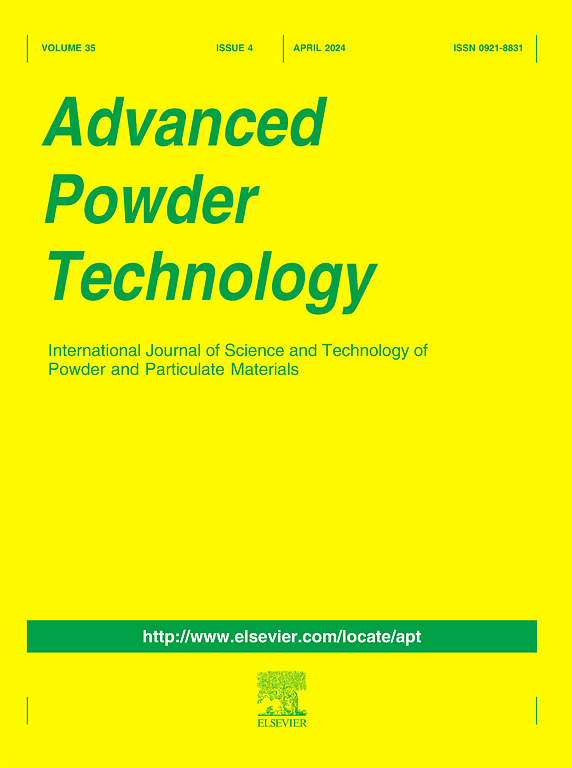深度自还原技术处理转炉炉渣和高炉粉尘的有效策略:协同反应和相演化行为
IF 4.2
2区 工程技术
Q2 ENGINEERING, CHEMICAL
引用次数: 0
摘要
先进的自还原焙烧技术是实现危险高炉和转炉炉渣清洁协同利用的一条简单途径。然而,目前还没有明确的金属化率与熔剂金属化球团破碎强度之间的关系。阐明了助熔剂金属化球团制备过程中的固结行为和协同机理。通过对工艺参数的综合优化,在还原温度为1200℃、还原时间为60 min、碱度为1.25、FC/O为0.9的最佳条件下,成功生产出破碎强度为3924 N/P、金属化率为86.54%、锌回收率为90.35%的金属化球团,满足了高炉生产原料的要求。锌铁氧体ZnxFe3-xO4和stirlingite ZnFeSiO4的还原行为对球团的制备起着至关重要的作用。在ZnxFe3-xO4的还原过程中,ZnxFe3-xO4先还原为浮士体ZnyFe1-yO,然后再还原为金属铁和锌。在ZnFeSiO4还原过程中,在CaO通量的作用下,橄榄石型ZnxFe2-xSiO4可以与CaO结合形成稳定的橄榄石CaSiO4, CaO的参与可以有效降低FeZnSiO4的还原活化能。此外,CayFe2-ySiAl2O7源于尖晶石晶体结构的CaxFe1-xAl2O4与橄榄石晶体结构的CaxFe2-xSiO4之间的位移反应。开发了一种深度自还原焙烧技术,为冶金固体废物资源的清洁利用提供技术支持和理论指导。本文章由计算机程序翻译,如有差异,请以英文原文为准。

An effective strategy for converter slag and blast furnace dust by a deep self-reduction technology: Synergetic reaction and phase evolution behavior
Advanced self-reduction roasting technology is a simple route for realizing the clean and synergetic utilization of hazardous blast furnaces and converter slag. However, the correlation between the crushing strength and metallization ratio of flux-metalized pellets has not been elucidated. This work clarified the consolidation behavior and synergetic mechanism in the preparation process of flux-metalized pellets. Through comprehensive optimization of process parameters, fluxed metalized pellets with a crushing strength of 3924 N/P, a metallization ratio of 86.54 % and a zinc recovery ratio of 90.35 % were successfully produced under the following optimal conditions: a reduction temperature of 1200 °C, a reduction time of 60 min, a basicity of 1.25 and an FC/O of 0.9, which meets the requirements for raw materials in blast furnace production. The reduction behavior of zinc ferrite ZnxFe3-xO4 and stirlingite ZnFeSiO4 played a crucial role in the preparation of pellets. During the reduction process of ZnxFe3-xO4, ZnxFe3-xO4 was initially reduced to wustite ZnyFe1-yO and then further reduced to metallic iron and zinc. During the reduction process of ZnFeSiO4, olivine-type ZnxFe2-xSiO4 could combine with CaO to form stable olivine CaSiO4 under the action of CaO flux, in which the participation of CaO could effectively decrease the reduction activation energy of FeZnSiO4. In addition, CayFe2-ySiAl2O7 originated from the displacement reaction between CaxFe1-xAl2O4, which has a spinel crystal structure, and CaxFe2-xSiO4, which has an olivine crystal structure. A deep self-reduction roasting technology was developed to provide technical support and theoretical guidance for the clean utilization of metallurgical solid waste resources.
求助全文
通过发布文献求助,成功后即可免费获取论文全文。
去求助
来源期刊

Advanced Powder Technology
工程技术-工程:化工
CiteScore
9.50
自引率
7.70%
发文量
424
审稿时长
55 days
期刊介绍:
The aim of Advanced Powder Technology is to meet the demand for an international journal that integrates all aspects of science and technology research on powder and particulate materials. The journal fulfills this purpose by publishing original research papers, rapid communications, reviews, and translated articles by prominent researchers worldwide.
The editorial work of Advanced Powder Technology, which was founded as the International Journal of the Society of Powder Technology, Japan, is now shared by distinguished board members, who operate in a unique framework designed to respond to the increasing global demand for articles on not only powder and particles, but also on various materials produced from them.
Advanced Powder Technology covers various areas, but a discussion of powder and particles is required in articles. Topics include: Production of powder and particulate materials in gases and liquids(nanoparticles, fine ceramics, pharmaceuticals, novel functional materials, etc.); Aerosol and colloidal processing; Powder and particle characterization; Dynamics and phenomena; Calculation and simulation (CFD, DEM, Monte Carlo method, population balance, etc.); Measurement and control of powder processes; Particle modification; Comminution; Powder handling and operations (storage, transport, granulation, separation, fluidization, etc.)
 求助内容:
求助内容: 应助结果提醒方式:
应助结果提醒方式:


